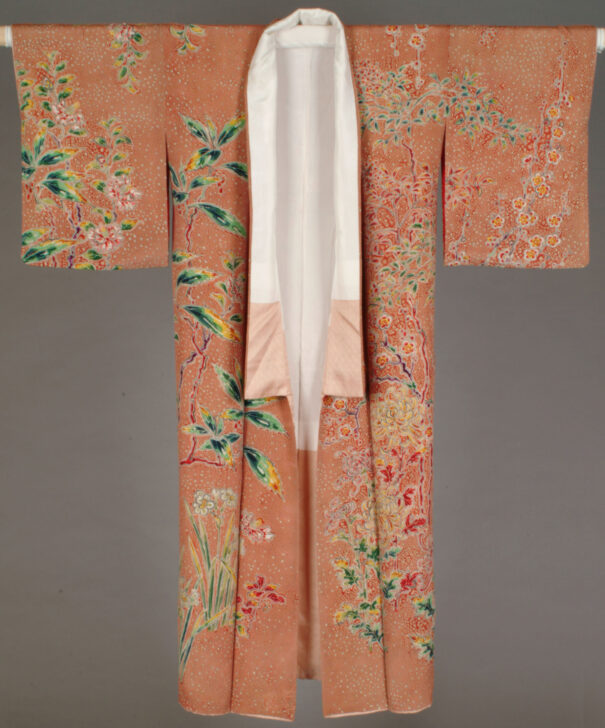Crested kimono with elaborate floral wax resist designs (hageito, nandina, biwa, camelia, daffodils, omoto, plums, thistles) against crackled pink-on-taupe ground, with embroidery in metallic threads
Minagawa Gekka

Description
Minagawa Gekka
Japan, 1892–1987
Kimono
Showa period (1926–89)
ca. 1950
Crepe silk with colorful wax resist design and metallic
thread embroidery
Gift of Howard and Patricia Yamaguchi, 2005/1.358
In this exuberant kimono, Minagawa Gekka took great advantage
of the wide, flat surface of the garment, effectively treating
it as a canvas on which to depict a profusion of flowers. The
design combines a mix of flowers and trees that bloom from
fall through very early spring: nandina on the left sleeve; plum,
chrysanthemums, thistles, amaranths, camellias, and narcissus
on the front and back; and makino (Chloranthus glaber) and more
camellias on the right sleeve. Due to the number of auspicious
winter blooms, it is possible this kimono was commissioned for
a New Year’s celebration.
Fall 2022 Gallery Rotation
Subject Matter:
In this exuberant kimono, Minagawa Gekka took great advantage of the wide, flat surface of the kimono, effectively treating it as a canvas on which to depict flowers blooming in profusion. There are mix of fall flowers, winter flowers and trees: nandin on the left sleeve, plum, chrysanthemums, thistles, amaranths, camellias and narcissus on the front and back, makino (Chloranthus glaber, with red berries) and more camellias on the right sleeve. Due to the sheer profusion of auspicious winter flowers, it is possible that this kimono was commissioned for a New Year’s celebration.
Physical Description:
This is a pink silk crepe kimono with wax-resist patterns, hand-painted design and metallic threads embroidery. The kimono is in full length and has elongated sleeves. The fabric is dyed with pink, leaving the family crest under the collar and the floral design part white. The red scale pattern is added using wax-resist technique. Then the design of multiple kinds of plants is hand-painted with white, red, yellow, and pale and blue green colors. There are mix of fall and winter flowers and trees: nandin on the left sleeve, plum, chrysanthemums, thistles, amaranths, camellias and narcissus on the front and back, makino (Chloranthus glaber, with red berries) and more camellias on the right sleeve. Embroidery is added in various metallic threads around the contours of flowers and leaves.
Usage Rights:
If you are interested in using an image for a publication, please visit https://umma.umich.edu/request-image/ for more information and to fill out the online Image Rights and Reproductions Request Form.